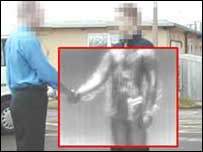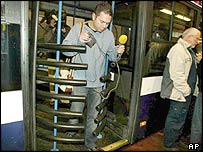|
By Tom Geoghegan
BBC News Magazine
|


The best weapon against terror?
|
The bombings in London showed how vulnerable public transport is to attack. Are there viable ways to reduce that risk?
After 9/11, airports introduced tighter security checks and armed air marshals boarded flights.
But public transport is much harder to protect. There were nearly one billion journeys made last year on the UK's network, which has 2,500 mainline railway stations and one of the biggest underground systems in the world.
The design is a triumph of convenience, so passengers hop on and off buses, Tubes and suburban trains without the check-in desk or long queues familiar to air travellers. And the stations are built to ease the passage of millions of people each day, with open spaces and multiple entries.
The Department of Transport says security is under constant review but it recognises the transport network is "essentially an open system" and what works in other cities may not work in the UK.
Following the Madrid rail attacks in March 2004, the UK government introduced measures such as enhanced CCTV and increased training of staff in spotting explosives.
And after last week's bombings, other options could be ruled in or ruled out.
BEAGLES
Sniffer dogs have been used in the UK to detect explosives, increasingly post-Madrid, but experts say the widespread use of beagles could be one answer. The dogs, made famous by cartoon character Snoopy, have been a hit at US airports such as Washington Dulles.
"Beagles are delightful and everyone goes 'Aaaah, they're cute, so it's not intrusive or scary," says security expert Bob Ayers, associate fellow of international think-tank Chatham House. "They are in keeping with the British tradition of policing - non-intrusive and non-threatening, unlike mastiffs or Rottweilers."
"I'd suggest using dogs in increasing numbers would help, but I doubt whether it would stop, say, someone getting a bus at Hammersmith."
The handler or police officer with the dog adds the vital ingredient of human judgement, he adds.
SNIFFER MACHINES
Machines to detect traces of explosives are already used in UK airports. Minute quantities of explosives could be traced from the handle of a bag put through a machine or combed with a handheld device.
 |
TRANSPORT TERROR
181 attacks worldwide on train and rail from 1998 to 2003
March 2004: 191 killed on Madrid trains
Feb 2004: Two blasts in or near Moscow's subway killed 51
July 1995: Eight killed on Paris train
1980: Bomb kills 75 at Bologna station
|
More advanced are vapour detectors, which "sniff" people or luggage, but this technology is still being developed. These would likely require portal detectors for passengers to walk through or could possibly be fitted on existing ticket barriers.
Using either machine on public transport would be tricky because of the delays they would probably cause. That means not only inconvenience but a security risk highlighted in Iraq, where queues of people have been attacked by insurgents.
"It terrifies me to hear that people want their luggage to be scanned before using public transport," says Philip Baum, managing director of security consultant Green Light.
"If you stop people getting on a train or a bus, you create targets. Whatever system you look at, you have to keep people moving.
"There's no point slowing people down to examine individuals because all that will do is distract our attention from the people posing a threat."
BODY SCANNERS
This technology has been tested at Gatwick Airport but its potential use on public transport is still some way away.

Infringing privacy or fair game?
|
The machines, called millimetre wave imagers, are able to "see" through clothes and could spot, for instance, explosives strapped to a person.
In theory, they would not require individuals to stop because they can cover crowded entrances. But it has yet to be tested on a transport hub as busy as Victoria or King's Cross, and would be very costly.
And staffing required would be huge - maybe as many as 20 people for one post over 24 hours, to watch footage and respond. Plus, passengers could complain their privacy was being invaded.
PROOF OF ID WHEN BUYING TICKETS
After 9/11, US rail firm Amtrak stopped selling tickets on board its trains between Washington and Boston. Instead passengers have to buy a ticket from an agent and produce picture ID to do so.
Alternatively, they can use a credit card in a machine, which is a validation of identity in itself. Security officials have discussed implementing a check of names against a watch list of suspects, but this has not yet been introduced.
Identity checks would not be effective, says Charles Shoebridge, a security analyst and former counter-terrorism intelligence officer.
"The availability of false documentation, plus the fact that with the government identity cards foreigners will not need one for three months, means if the system can still be so easily circumvented, we may as well have no system at all," he says.
It would only be possible for a limited number of journeys, says Mr Ayers, because otherwise there would be millions of ID checks required each day, with decisions on whether to let the person travel made for each instance.
X-RAY SCREENS
Screens similar to the airport checks on hand luggage were tested at Maryland station in the US. Passengers and their luggage were screened on the platform before the train arrived, and the month-long pilot in May showed the average waiting time per passenger was two minutes.
In the UK, a delay of that length would bring the Tube and bus networks to a stop, but may not be so inconvenient at mainline railway stations.
Again, very labour-intensive.
BOMB-PROOF BUSES

Turnstiles on buses were tested in Jerusalem
|
Turnstile barriers operated by bus drivers and equipped with hidden bomb sensors were piloted in Jerusalem last year as the number of suicide bomb attacks increased.
But the UK is a different matter, says Mr Ayers, because the size of its bus fleet would make this a very expensive exercise.
"You could spend lots of money on stopping people taking a bomb on to a bus but that's not going to stop them throwing the bomb under the bus or at a taxi cab.
"Will it stop terrorism or just move it on to something else? It could mean spending a lot of money, irritating people and not having the expected results."
TRAIN MARSHALS
Could trains follow the lead of planes with armed marshals?
Police officers patrolled Madrid's transport network immediately after the bombings, just as the police presence has now increased on the UK's.
Guards used to operate on every Tube train and Professor Chris Bellamy, director of the Security Studies Institute, says reviving a more skilled version to prevent terror attacks would be effective but unlikely.
"Training people like that would be hugely expensive and I'm not sure it would be feasible," he says.
And without an armed police force, it's unlikely guards would be armed, he adds.
OTHER OPTIONS
Facial recognition CCTV has been developed which manufacturers claim can match a face in the crowd with the mugshot of a known suspect. Newham in east London uses this technology in its CCTV system but critics claim it has had little success in recognising criminals.
There is also technology which tracks movement and can contact officials if someone appears to act suspiciously.
But neither system is yet sophisticated enough for mass transport.
Toughened glass on carriages is a way to minimise injury by stopping it shattering after an explosion, but it's not a preventive measure.
WHAT'S THE BEST?
Once the intelligence fails and the bomber reaches his target, there's not much can be done, says Mr Shoebridge. "Thursday's attacks may have disrupted the Tube system for days but inappropriate security measures would disrupt it, and the public, on a permanent basis."
There are no magic solutions but beagles are the best option, says Mr Ayers, who believes measures which slow down the freedom of travel risk changing the fabric of British society.
"If you want to protect against terrorism, you don't protect at the point of delivery. You have to protect before that, by better intelligence."
The best form of counter-terrorism is the human eye, says Mr Baum.
"We simply have to be aware of people who stand out from a crowd. Some people might not be identifiable by their behaviour but we'll identify far more by their behaviour than by technology."

